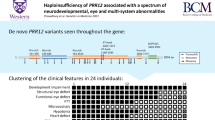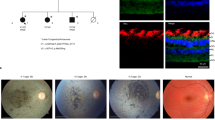Abstract
Deficiency of ornithine–δ–aminotransferase (OAT) in humans causes hyperornithinaemia and gyrate atrophy (GA), a blinding chorioretinal degeneration. Surprisingly, OAT–deficient mice produced by gene targeting exhibit neonatal hypoornithinaemia and lethality, rescuable by short–term arginine supplementation. Post–weaning, these mice develop hyperornithinaemia similar to human GA patients. Subsequent studies in one human GA infant also showed transient hypoornithinaemia. Thus, the OAT reaction plays opposite roles in neonatal and adult mammals. Over several months, OAT–deficient mice develop a retinal degeneration with involvement of photoreceptors and pigment epithelium. OAT–deficient mice appear to be an excellent model of human GA.
This is a preview of subscription content, access via your institution
Access options
Subscribe to this journal
Receive 12 print issues and online access
$209.00 per year
only $17.42 per issue
Buy this article
- Purchase on Springer Link
- Instant access to full article PDF
Prices may be subject to local taxes which are calculated during checkout
Similar content being viewed by others
References
Valle, D. & Simell, O. The hyperornithinaemias. in The Metabolic and Molecular Bases of Inherited Disease (eds Scriver, C., Beaudet, A., Sly, W. & Valle, D.) 1147–1185 (McGraw Hill, New York, 1995).
Mitchell, G. et al. Human ornithine-δ-aminotransferase: cDNA cloning and analysis of the structural gene. J. biol. Chem. 263, 14288–14295 (1988).
Mitchell, G. et al. An initiator codon mutation in ornithine-δ-aminotransferase causing gyrate atrophy. J. clin. Invest. 81, 630–633 (1988).
Michaud, J. et al. Strand-separating conformational polymorphism (SSCP) analysis: efficacy of detection of point mutations in the human ornithine-S-aminotransferase gene. Genomics 13, 389–394 (1992).
Brody, L.C. et al. Ornithine-δ-aminotransferase mutations causing gyrate atrophy: alelic heterogeneity and functional consequences. J. biol. Chem. 267, 3302–3307 (1992).
Wilson, D.J., Weleber, R.G. & Green, W.R. Ocular clinicopathologic study of gyrate atrophy. Am. J. Ophthalmol. 111, 24–33 (1991).
McMahon, A. & Bradley, A., The Wnt-1 proto-oncogene is required for development of a large region of the mouse brain. Cell 62, 1073–1085 (1990).
Mansour, S., Thomas, K. & Capecchi, M. Disruption of the proto-oncogene int-2 in mouse embryo-derived stem cells: a general strategy for targeting mutations to non-selectable genes. Nature 336, 348–352 (1988).
Ramirez-Solis, R. et al. Genomic DNA microextraction: a method to screen numerous samples. Anal. Biochem. 201, 331–335 (1993).
Lamb, B. et al. Induction and expression of the 400 kilobase amyloid precursor protein gene in transgenic mice. Nature Genet. 5, 22–30 (1993).
Hurwitz, R. & Kretchmer, N. Development of arginine-synthesizing enzymes in mouse intestine. Am. J. Physiol. 251, G103–G110 (1986).
Jones, M. Conversion of glutamate to ornithine and proline. Pyrroline-5-carboxylate, a possible modulator of arginine requirements. J. Nutr. 115, 509–515 (1985).
Riby, J., Hurwitz, R. & Kretchmer, N. Development of ornithine metabolism in the mouse intestine. Pediatr. Res. 28, 261–265 (1990).
Morris, J. & Rogers, Q. Ammonia intoxication in the near-adult cat as a result of a dietary deficiency of arginine. Science 199, 431–432 (1978).
Morris, J. & Rogers, Q. Arginine: an essential amino acid for the cat. J. Nutr. 108, 1944–1953 (1978).
Stewart, P., Walser, M., Batshaw, M. & Valle, D. Effects of arginine-free meals on ureagenesis in cats. Am. J. Physiol. 241, 310–315 (1981).
Windmueller, H. & Spaeth, A. Intestinal metabolism of glutamine and glutamate from the lumen as compared to glutamine from blood. Arch. Biochem. Biophys. 171, 662 (1975).
Wakabayashi, Y., Yamada, E., Hasegawa, T. & Yamada, R. Enzymological evidence for the indispensability of small intestine in the synthesis of arginine from glutamate. I. Pyrroline-5-carboxylate synthase. Arch. Biochem. Biophys. 291, 1–8 (1991).
Kerwin, J.J. & Heller, M. The arginine-nitric oxide pathway: a target for new drugs. Medic. Res. Rev. 14, 23–74 (1994).
Hauser, E., Finkelstein, J., Valle, D. & Brusilow, S. Allopurinol-induced orotidinuria: A test for mutations at the ornithine transcarbamylase locus in women. New Engl. J. Med. 322, 1641–1645 (1990).
Mitchell, G. et al. At least two mutant alleles of ornithine-δ-aminotransferase cause gyrate atrophy of the choroid and retina in Finns. Proc. natn. Acad. Sci. U.S.A. 86, 197–201 (1989).
Altman, P.L. & Dittmer, D.S. in Biology Data Book, 2nd ed., 195–210 (Federation of American Society of Experimental Biology, Bethesda, 1972).
Davis, T.A., Fiorotto, M.L. & Reeds, P.J. Amino acid composition of body and milk proteins change during the suckling period in rats. J. Nutr. 123, 947–956 (1993).
Carey, G.P. et al. An arginine-deficient diet in humans does not evoke hyperorotic acidaemia. J. Nutr. 117, 1734–1739 (1987).
Patejunas, G., Bradley, A., Beaudet, A. & O'Brien, W. Generation of a mouse model for citrullinaemia by targeted disruption of the argininosuccinate synthetase gene. Somat. Cell. molec. Genet. 20, 55–60 (1994).
Watanabe, M. et al. Mice deficient in cystathionine β-synthase: Animal models for mild and severe homocyst(e)inemia. Proc. natn. Acad. Sci. U.S.A. 92, 1585–1589 (1995).
Wakamiya, M. et al. Disruption of the adenosine deaminase gene causes hepatocellular impairment and perinatal lethality in mice. Proc. natn. Acad. Sci. U.S.A. 92, 3673–3677 (1995).
Migchielsen, A.A.J. et al. Adenosene deaminase-deficient mice die perinatally and exhibit liver-cell degeneration, atelectasis and small intestinal cell death. Nature Genet. 10, 279–287 (1995).
Brusilow, S.W. in Techniques in Human Biochemical Genetics (ed. Hommes, F.) 345–357 (Wiley-Liss, New York, 1991).
Author information
Authors and Affiliations
Rights and permissions
About this article
Cite this article
Wang, T., Lawler, A., Steel, G. et al. Mice lacking ornithine–δ–amino–transferase have paradoxical neonatal hypoornithinaemia and retinal degeneration. Nat Genet 11, 185–190 (1995). https://doi.org/10.1038/ng1095-185
Received:
Accepted:
Issue Date:
DOI: https://doi.org/10.1038/ng1095-185
This article is cited by
-
Metabolites, gene expression, and gut microbiota profiles suggest the putative mechanisms via which dietary creatine increases the serum taurine and g-ABA contents in Megalobrama amblycephala
Fish Physiology and Biochemistry (2023)
-
Proline metabolism and transport in retinal health and disease
Amino Acids (2021)
-
Reference values of amino acids and of common clinical chemistry in plasma of healthy infants aged 1 and 4 months
Journal of Inherited Metabolic Disease (2016)
-
Ornithine Aminotransferase Deficiency in Differential Diagnosis of Neonatal Hyperammonemia: A Case with a Novel OAT Gene Mutation
The Indian Journal of Pediatrics (2016)
-
Underestimated contribution of skeletal muscle in ornithine metabolism during mouse postnatal development
Amino Acids (2014)



